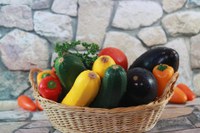Prairie Fare: Is that a zucchini on my porch?
(Click an image below to view a high-resolution image that can be downloaded)
By Julie Garden-Robinson, food and nutrition specialist
NDSU Extension
“Mom, it looks like a cucumber but smells like the sea!” my older daughter commented. She was a lot younger then.
She was admiring two small shiny green zucchinis on our counter.
She rolled them around and sniffed them again.
I’m not sure that why she thought it “smelled like the sea.” She had never visited any oceans.
I sniffed it too, hoping it was at its prime. The zucchini had a fresh “green” smell.
I was happy that I had picked it before it became the size of a baseball bat.
Zucchini plants are very prolific. Given good growing conditions, you might have more zucchini than you imagined possible.
Zucchinis often are featured in jokes. “National Sneak Some Zucchini Onto Your Neighbor’s Porch Day” was commemorated on Aug. 8.
I missed it. I didn’t plant any zucchini this year.
Zucchini is a member of the Cucurbitaceae family. This family has hundreds of relatives and includes cucumbers, summer squash, gourds, melons, pumpkin, watermelon, cantaloupe and many others.
Technically, zucchinis are “fruits” of the plant according to botanists. In the nutrition field, we consider them vegetables because of the way we use them on menus.
Zucchini has some different names around the world.
If someone offered you some “courgette” bread, would you eat it? “Courgette” is the French name for zucchini harvested when fairly small. The word means “little squash.” Most of us have tasted zucchini bread or muffins.
How about some “baby marrow”? Baby marrow is another name for zucchini. It refers to harvesting the fruit when it is finger-sized. As you can see, the vegetable has nothing to do with babies or bone marrow.
Zucchini is used worldwide in soups, stews, as spreads, and in pancakes, breads and other grain-based foods. Its bland flavor makes it a versatile addition to many types of foods, from sweet to spicy.
Zucchini won’t set you back in terms of calorie management. One cup of zucchini has less than 20 calories. You can prepare it on the grill, in a microwave, air-fryer or in an oven.
You can steam, grill, saute or make chips from zucchini. You can shred it and add it to meatballs or meatloaf as a vegetable-based meat extender.
The flowers are edible. As a bonus, eating the flowers will limit further zucchini production.
Have you tried “zoodles”? These are thin strips of zucchini prepared with a peeler or special tool called a “spiralizer.” Top steamed zoodles with your favorite pasta sauce for a unique dish.
If your zucchini has grown larger than expected, try making zucchini boats. Cut each zucchini in half lengthwise and scoop out the seeds. Then drizzle it with your favorite cooking oil and season as desired. Roast cut-side down until tender for 30 to 60 minutes, depending on size. Then fill your boat with your favorite casserole, taco meat or seasoned bread stuffing.
If you have eaten or given away as much zucchini as you can manage, you can preserve it through freezing or pickling. Check out the National Center’s Summer Squash Relish (available at https://nchfp.uga.edu/how/can_06/summer_squash_relish.html).
Remember to use research-tested recipes for all canning endeavors. We do not recommend canning summer squash, which is a low-acid food. The U.S. Department of Agriculture and the National Center for Home Food Preservation do not have safe, tested recipes for canning zucchini or other summer squash. See www.ag.ndsu.edu/food and navigate to “Food Preservation” for food preservation details.
To freeze zucchini, rinse it, then grate or slice it with or without the skin. Then blanch (scald) in boiling water for one minute if grated or three minutes if sliced. Drain thoroughly, then package in freezer containers. Label with contents and date. Remember to drain it well before adding to your favorite recipe.
If you do not have a garden or generous neighbor with zucchini, stop at a local farmers market or grocery store. Here’s a recipe you can personalize to what you have available and your taste preferences. Try adding some eggplant or use another type of summer squash.
Skillet Zucchini with Chopped Tomatoes
1 teaspoon olive oil or canola oil
1 cup chopped onion
4 small (6-inch) zucchini, thinly sliced (or other summer squash)
2 medium tomatoes, chopped
Freshly ground pepper
Italian seasoning (optional)
Grated parmesan cheese (optional)
In a large, nonstick skillet, heat oil over medium heat; add onions and cook, stirring until softened. Add zucchini and cook for two minutes. Add tomatoes and cook for three to five minutes or until zucchini is tender-crisp. Season to taste with pepper and add a sprinkle of Parmesan cheese if you wish.
Makes four servings. Each (1-cup) serving has 70 calories, 2 grams (g) fat, 3 g protein, 12 g carbohydrate and 15 milligrams sodium.
(Julie Garden-Robinson, Ph.D., R.D., L.R.D., is a North Dakota State University Extension food and nutrition specialist and professor in the Department of Health, Nutrition and Exercise Sciences. Follow her on Twitter @jgardenrobinson)
NDSU Agriculture Communication – Aug. 18, 2022
Source: Julie Garden-Robinson, 701-231-7187, julie.garden-robinson@ndsu.edu
Editor: Elizabeth Cronin, 701-231-5391, elizabeth.cronin@ndsu.edu




